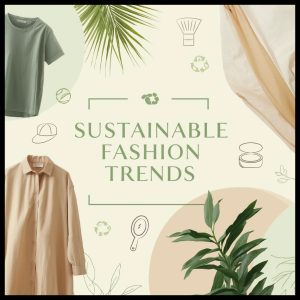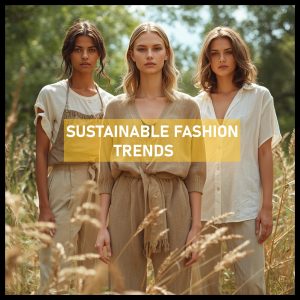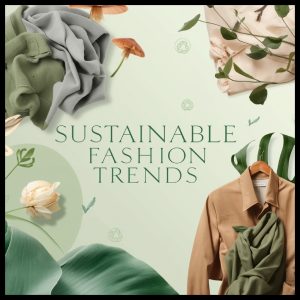Table of Contents
ToggleSustainable Fashion Trends
In today’s world, Sustainable Fashion Trends are no longer just a passing movement — they represent a cultural revolution. As people become more aware of the environmental and ethical issues surrounding the fashion industry, a new generation of conscious consumers is emerging. These individuals are redefining what it means to be stylish by prioritizing sustainability, transparency, and responsibility. The fashion industry, known for its fast cycles and wasteful production, is undergoing a transformation where quality, longevity, and eco-consciousness are becoming the new hallmarks of style.

The shift towards Sustainable Fashion Trends is fueled by growing awareness of climate change, pollution, and the exploitation of labor in developing countries. From recycled fabrics to ethical supply chains, the concept of “slow fashion” is taking root. Brands that once prioritized mass production and quick profit are now rethinking their values. This transformation is not only redefining how we dress but also reshaping how we connect with the world around us. It’s a journey toward mindful consumption, one stitch at a time.
The Evolution of Sustainable Fashion
To understand the rise of Sustainable Fashion Trends, we need to look at how the fashion industry has evolved over the past few decades. Fast fashion, characterized by cheap materials, rapid production, and disposable clothing, became the norm in the 2000s. Consumers were drawn to affordability and variety — but at a hidden cost. Massive textile waste, water pollution, and unethical labor practices became rampant.
The new generation of consumers, especially Gen Z and millennials, are demanding change. They are choosing to support ethical fashion brands that respect workers’ rights and minimize environmental harm. The movement is shifting from mass consumption to meaningful curation. With technology and innovation, brands can now trace their supply chains, ensure fair wages, and use eco-friendly materials like organic cotton, hemp, and recycled polyester.
As the industry embraces Sustainable Fashion Trends, designers are focusing on creating timeless pieces rather than disposable outfits. The trend has evolved into a lifestyle — one that encourages self-expression while caring for the planet. The philosophy is simple: buy less, choose well, make it last.
Why Sustainability Matters in Fashion
The global fashion industry is responsible for about 10% of all greenhouse gas emissions and 20% of wastewater production. This makes it one of the most polluting industries on the planet. Adopting Sustainable Fashion Trends is crucial to reversing this damage. Every piece of clothing has a story — from the raw materials used to the workers who stitch it together. Sustainable fashion ensures that this story is ethical, transparent, and kind to the Earth.
A single cotton T-shirt requires approximately 2,700 liters of water — enough for one person to drink for nearly three years. Fast fashion’s reliance on synthetic fibers like polyester adds to the problem because these materials shed microplastics into oceans during washing. On the other hand, sustainable practices promote eco-friendly fabrics, low-impact dyes, and reduced waste through innovative production methods.
Moreover, sustainable fashion addresses social justice issues by promoting fair trade and supporting artisans who create handmade, durable products. The movement encourages consumers to think before they buy — to invest in pieces that tell a meaningful story and contribute to global well-being.
Circular Fashion
One of the most significant Sustainable Fashion Trends today is circular fashion, which aims to eliminate waste entirely. In a circular model, clothing is designed to last longer, be reused, repaired, and eventually recycled. This concept contrasts sharply with the “take-make-dispose” system of fast fashion.
Circular fashion encourages practices such as clothing rental, secondhand shopping, and upcycling. Platforms like Depop, Poshmark, and Vinted have revolutionized resale culture by allowing consumers to give pre-loved clothing a second life. Similarly, brands are now designing garments with recycling in mind — using mono-material fabrics that are easier to repurpose.
Companies are also implementing take-back programs, where customers return used clothing to be repaired or recycled into new pieces. For example, major retailers now recycle old denim into insulation material or new jeans. These efforts reflect how Sustainable Fashion Trends are merging innovation with responsibility, ensuring that style no longer comes at the cost of the planet.
Ethical Production and Transparency
Transparency is the backbone of sustainability. In the era of Sustainable Fashion Trends, consumers demand to know where their clothes come from, who made them, and under what conditions. Ethical fashion brands are responding by publishing supply chain data and ensuring every stage of production aligns with eco-friendly and humane practices.
Modern consumers value ethical manufacturing over mindless consumption. Brands that disclose factory locations, labor conditions, and environmental impact are earning the trust of shoppers who prioritize integrity. This transparency creates accountability and encourages competition toward better standards.
Additionally, slow fashion emphasizes craftsmanship — valuing the hands and hearts behind each garment. By supporting artisans and small-scale producers, ethical fashion creates opportunities for communities while preserving traditional skills. The result is clothing that carries not just style, but soul.
Innovative Materials and Eco-Friendly Textiles
The innovation in Sustainable Fashion Trends goes beyond design — it starts with the very fabric. Traditional textiles like cotton and polyester have heavy ecological footprints, but new alternatives are paving the way for a greener future.
Some notable innovations include:
-
Organic cotton, which eliminates harmful pesticides and reduces water use.
-
Hemp, known for durability and minimal resource requirements.
-
Tencel (Lyocell), made from sustainably sourced wood pulp using closed-loop processing.
-
Recycled polyester, which transforms plastic bottles into soft, wearable fabric.
-
Piñatex, derived from pineapple leaves, offering a vegan alternative to leather.
-
Mushroom leather and apple leather, biodegradable materials revolutionizing the accessory market.
These fabrics not only reduce environmental damage but also create exciting design opportunities. They redefine luxury — proving that sustainability and elegance can coexist harmoniously. The future of Sustainable Fashion Trends is being woven with innovation, compassion, and creativity.
Minimalism and Conscious Consumerism
Minimalism has become one of the most influential Sustainable Fashion Trends of the decade. The idea is simple yet powerful: less is more. Conscious consumers are moving away from cluttered wardrobes filled with impulsive purchases and embracing curated collections of timeless essentials.
This mindset encourages capsule wardrobes, where a small number of versatile items can be mixed and matched for countless looks. It prioritizes quality over quantity and individuality over trends. Consumers are learning to invest in well-made pieces that last years instead of months.
Minimalism also promotes mindful shopping — buying only when necessary, repairing instead of discarding, and appreciating craftsmanship. It’s not about deprivation; it’s about liberation. By consuming less, we not only reduce waste but also rediscover personal style that reflects authenticity and purpose.
Technology’s Role in Sustainable Fashion
Technology is reshaping how we design, produce, and consume fashion. In the realm of Sustainable Fashion Trends, digital innovation has become a driving force for change. Artificial intelligence and big data help predict consumer demand, reducing overproduction and waste. Meanwhile, 3D design tools allow designers to prototype digitally, minimizing fabric waste.
Blockchain technology enhances supply chain transparency by tracking garments from origin to purchase. Consumers can scan a QR code to see where a product was made and whether it meets sustainability standards.
Furthermore, virtual fashion shows and digital clothing are gaining popularity, reducing the environmental cost of traditional runways. Even augmented reality (AR) try-on features help customers shop more consciously by visualizing fits before buying, thus cutting down on returns and waste.
With these advancements, technology proves to be an ally in the pursuit of a sustainable and ethical fashion ecosystem.

The Rise of Thrift Culture
Thrifting has evolved from a niche hobby into one of the most significant Sustainable Fashion Trends in recent years. Secondhand shopping not only saves money but also reduces demand for new clothing production. Vintage fashion has made a comeback, proving that style truly is timeless.
Thrift stores and online resale platforms are redefining how people perceive pre-owned clothes. The stigma once associated with secondhand items has disappeared, replaced by the pride of conscious choice. Shoppers love the thrill of finding unique pieces with character and history.
Moreover, thrift culture supports community charities and local economies. It promotes a circular economy where resources stay in circulation instead of ending up in landfills. Every thrifted purchase is an act of environmental activism — a vote against waste and overconsumption.
Sustainable Fashion Influencers and Social Awareness
Social media has played a monumental role in spreading Sustainable Fashion Trends worldwide. Influencers and activists are using their platforms to educate audiences about ethical shopping, slow fashion, and environmental responsibility. Through honest storytelling, they’re inspiring millions to rethink their consumption habits.
These voices bridge the gap between brands and consumers, holding corporations accountable for their sustainability claims. They highlight greenwashing — the deceptive marketing practice of exaggerating eco-friendly efforts — and push for genuine change.
By promoting transparency and ethical values, influencers are turning sustainability into a mainstream conversation. The power of awareness has never been stronger, and it continues to drive the global movement toward conscious fashion.
The Economic Benefits of Sustainable Fashion
Contrary to popular belief, Sustainable Fashion Trends don’t just benefit the environment — they make economic sense too. While eco-friendly production can seem costlier initially, it builds long-term value through durability, customer loyalty, and resource efficiency.
Consumers are increasingly willing to pay more for sustainable products. According to global surveys, nearly 70% of shoppers prefer brands that take a stand for social or environmental issues. This shift in mindset encourages businesses to innovate responsibly and adopt sustainable business models.
Additionally, sustainability opens new job opportunities in recycling, textile innovation, and green manufacturing. It transforms the economy by merging ethics with profitability — a win-win for both people and the planet.
Future of Sustainable Fashion
The future of Sustainable Fashion Trends looks promising, with continuous innovation and global collaboration. Designers are experimenting with 3D printing, zero-waste patterns, and digital materials that minimize environmental harm. Governments are enforcing stricter regulations to reduce pollution and encourage ethical sourcing.

Education will play a vital role in shaping this future. Fashion schools are now integrating sustainability into their curriculums, nurturing a new generation of eco-conscious designers. As awareness spreads, sustainability will no longer be a niche — it will be the standard.
The journey ahead is challenging, but progress is undeniable. By aligning creativity with conscience, fashion can become a force for good, influencing industries far beyond its borders.
Final Thoughts
The movement toward Sustainable Fashion Trends is more than a trend — it’s a revolution that redefines beauty, responsibility, and culture. In a world plagued by overconsumption and waste, sustainability offers hope. It reminds us that every garment has value, every choice matters, and every action counts.
Fashion doesn’t have to harm; it can heal. By supporting ethical brands, embracing minimalism, and demanding transparency, we can build a future where style and sustainability coexist in harmony. The ultimate goal is not perfection but progress — one thoughtful purchase at a time.
Together, we can transform fashion into a symbol of creativity, compassion, and care for the planet. The next era belongs to conscious consumers and visionary designers who understand that true style never fades — it evolves, responsibly.
